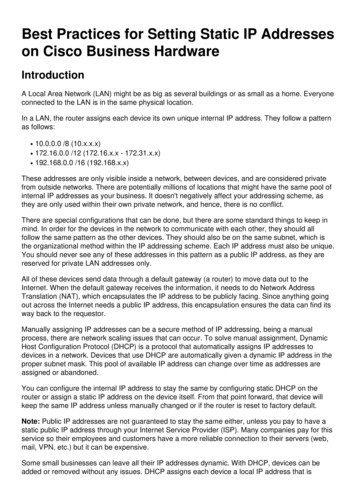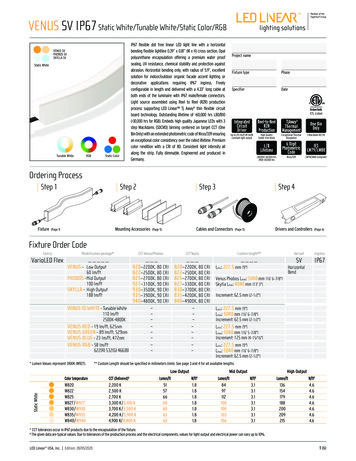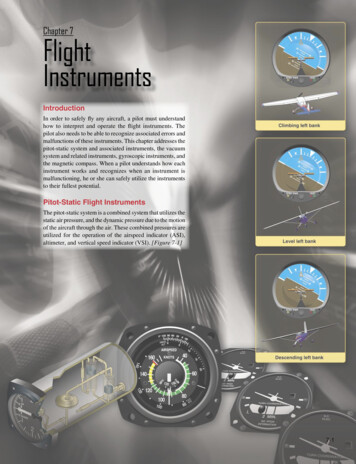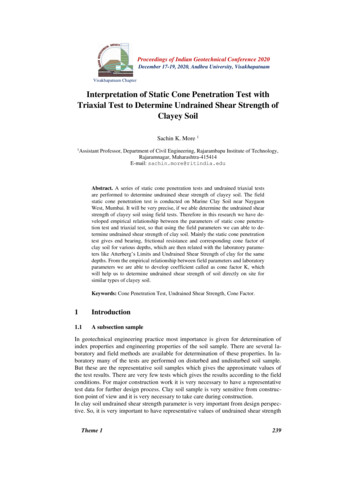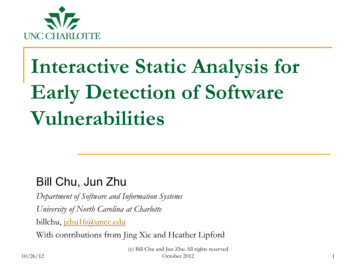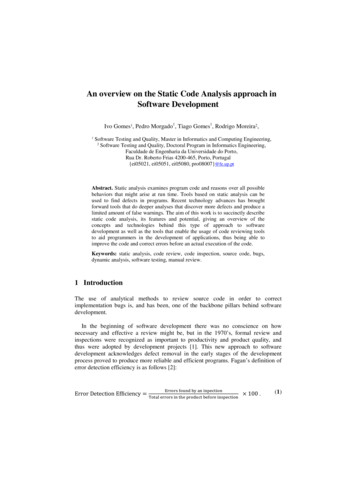
Transcription
An overview on the Static Code Analysis approach inSoftware DevelopmentIvo Gomes1, Pedro Morgado1, Tiago Gomes1, Rodrigo Moreira2,1Software Testing and Quality, Master in Informatics and Computing Engineering,2Software Testing and Quality, Doctoral Program in Informatics Engineering,Faculdade de Engenharia da Universidade do Porto,Rua Dr. Roberto Frias 4200-465, Porto, Portugal{ei05021, ei05051, ei05080, pro08007}@fe.up.ptAbstract. Static analysis examines program code and reasons over all possiblebehaviors that might arise at run time. Tools based on static analysis can beused to find defects in programs. Recent technology advances has broughtforward tools that do deeper analyses that discover more defects and produce alimited amount of false warnings. The aim of this work is to succinctly describestatic code analysis, its features and potential, giving an overview of theconcepts and technologies behind this type of approach to softwaredevelopment as well as the tools that enable the usage of code reviewing toolsto aid programmers in the development of applications, thus being able toimprove the code and correct errors before an actual execution of the code.Keywords: static analysis, code review, code inspection, source code, bugs,dynamic analysis, software testing, manual review.1 IntroductionThe use of analytical methods to review source code in order to correctimplementation bugs is, and has been, one of the backbone pillars behind softwaredevelopment.In the beginning of software development there was no conscience on hownecessary and effective a review might be, but in the 1970’s, formal review andinspections were recognized as important to productivity and product quality, andthus were adopted by development projects [1]. This new approach to softwaredevelopment acknowledges defect removal in the early stages of the developmentprocess proved to produce more reliable and efficient programs. Fagan’s definition oferror detection efficiency is as follows [2]:Error Detection Ef iciency ! 100 .(1)
So, as far as source code is concerned, it is in the best interest of the programmer totake advantage of static analysis. Although this does not imply that other forms ofsoftware analysis should be discouraged, on the contrary, the best way to certify thatan implementation has the least amount of errors or defects is by combining both thestatic and the dynamic measures of analysis.The static analysis approach is meant to review the source code, checking thecompliance of specific rules, usage of arguments and so forth; the dynamic approachis essentially executing the code, running the program and dynamically checking forinconsistencies of the given results. This means that testing and reviewing code areseparate and distinguishable things, but it is unadvised that one should occur withoutthe other, and it is also arguable as to what should be done first, testing or reviewingsoftware [3].This work focuses on the description of the static methods of analysis, with aspecial attention to the available tools in the market that provide this kind of service.This paper is organized in the following sections: Section 1, this current section,introduced the static analysis approach; Section 2 will describe a relative briefoverview of static analysis, followed by the description of the most common methodsof code reviewing done by humans: self review, walkthrough, peer review, inspectionand audit. In order to ascertain the truly fundamental qualities of static code analysisand more importantly, to distinguish them from the dynamical testing approaches,Section 3 will describe the advantages and disadvantages regarding static analysis. Acomprehensive comparison between code review and testing shall explain why theusage of just one of them is discouraged; Section 4 will summarize a listing of themost popular software tools that are capable of performing this type of code analysiswhich shall be followed by a comparison between some aspects of these tools; afurther evaluation of these tools is described in Section 5; in Section 6 will featuresome possible enhancements to be performed on such tools; and finally Section 7 willexpress a discussion over static code analysis tools in software development.2 Overview of the Static Analysis approachStatic code analysis is the analysis of computer software which is performed withoutthe actual execution of the programs built from that software, as opposite of dynamicanalysis (testing software by executing programs). For the majority of cases theanalysis is performed on some version of the source code and in the other cases someform of the object code. The term is usually applied to the analysis performed by anautomated software tool, with human analysis being called program understanding,program comprehension or code inspection.It can be argued that software metrics and reverse engineering are forms of staticanalysis, but such discussion is not the aim of this work.Programmers make little mistakes all the time, like a missing semicolon here, anextra parenthesis there, and so on. Most of the time these gaffes are inconsequential,
the compiler notes the error, the programmer fixes the code, and the developmentprocess continues. However, this quick cycle of feedback and response normally doesnot apply to most security vulnerabilities, which can lie dormant for an indefiniteamount of time before discovery. As explained earlier, the longer a defect on thesoftware lies dormant, the more expensive it can be to fix [4].The promise of static analysis is to identify many common coding problemsautomatically before a program is released. Static analysis aims to examine the text ofa program statically, without attempting to execute it. Theoretically, static analysistools can examine either a program’s source code or a compiled form of the programto equal benefit, although the problem of decoding the latter can be difficult [4].2.1 Manual ReviewManual reviewing or auditing is a form of static analysis, very time-consuming, andto perform it effectively, human code auditors must first know what type of errorsthere are supposed to find before they can rigorously examine the code.The reviewing of an application’s code can be done in any phase of softwaredevelopment, but the best results are when this is done at an early stage, because thecosts and risk of detecting and correcting security vulnerabilities and quality defectslate in the software development process can be high. When those bugs escape intothe market and are discovered by customers, the fallout can affect the bottom line anddamage reputations [5].Reviewing includes not only the code, but all documentation, requirements anddesigns the developer produces, everything is susceptible of being review, becausethere can be errors hidden in every step of software development.Basically, static code analysis performed by humans can be divided in two majorcategories: self reviews and 3rd party reviews, which are tightly related to the PersonalSoftware Process and the Team Software Process [6].In the picture below, the initial phase shows the actual implementing of the code,which obviously isn’t any type of static analysis. Following is the self review of thewritten code, where the programmer tries to evaluate and correct by himself the codehe implemented. The walkthrough focuses on the presentation to an audience of thecode in question by its programmer. The peer review is when the programmerpresents his code to a colleague to review. Finally the inspection and audit, which isusually done by a third party of evaluators, the audit being the highest formal review[5].
Fig. 1. Flow of types of reviews that increase formality.The best way to detect and correct bugs in an early stage of development is whenthe programmer himself performs the review and tries to find and correct problems inhis code, this is commonly known as self review.In every programmer there should be a sense of personal responsibility in hisimplementations, and as such, it is always a good idea to try and keep track of themost common mistakes he does. This way in time it will become easier to preventrepeating them once again.There are some guidelines as to how to perform a proper self review: producingreviewable items (code, design, specifications, etc.); trying not to review code onscreen, to circumvent the tendency to correct bugs as they are found; not reviewing
the code right after it is written; to follow a structured review process; create personalchecklists of the most common mistakes; taking enough time to review the code, so asto be certain that everything is as it should be (usually half the time it was required towrite the code is more than enough to properly review it) [7].The team review process can be a bit more complex, and there several differentsteps in reviewing software as a group of people. An interesting method is thewalkthrough, in which the developer explains his code and ideas to an audience, beingsubject to their criticism. In addition, there are formal requisites to perform staticreviews of code.This kind of group review can be achieved with a before-after technique, meaningthere is a necessity of a review plan prior to the review (assembled by the leadingreviewer) and a review report that contains all the results.The components of a formal review plan are: the review goals, the collection ofitems being reviewed, a set of preconditions for the review, roles, team size,participants, training requirements, review steps and procedures, checklists and otherrelated documents to be distributed to participants, the time requirements, the natureof the review log and summary report, and rework and follow-up criteria andprocedures.The list of components of a formal review report: checklist will all items checkedand commented, list of defects found, list of attendees, review metrics (time and effortspent, size of the item being reviewed in lines of code or pages, number of defectsfound and ratios of defects/time, defects/size and size/time), status of the revieweditem (if it is accepted or to be re-inspected, depending on the number and gravity ofdefects found), estimate of rework effort and date for completion [7].2.2 Usage of automated tools for static analysisStatic analysis tools compare favorably to manual reviews because they’re faster,which means they can evaluate programs much more frequently, and they encapsulatesome of the knowledge required to perform this type of code analysis in a way that itisn’t require the tool operator to have the same level of expertise as a human auditor.Just as a programmer can rely on a compiler to consistently enforce the finer points oflanguage syntax, the operator of a good static analysis tool can successfully apply thattool without being aware of the finer points of the more hard to find bugs.Furthermore, testing for errors like security vulnerabilities is complicated by the factthat they often exist in hard-to-reach states or crop up in unusual circumstances. Staticanalysis tools can peer into more of a program’s dark corners with less fuss thandynamic analysis, which requires actually running the code. Static analysis has alsothe potential to be applied before a program reaches a level of completion at whichtesting can be meaningfully performed [4].Good static analysis tools must be easy to use, this means that their results must beunderstandable to normal developers who might not know much about security andthat they educate their users about good programming practice. Another criticalfeature is the kind of knowledge (the rule set) the tool enforces. The importance of agood rule set can’t be overestimated. In the end, good static checkers can help spot
and eradicate common security bugs. Static analysis for security should be appliedregularly as part of any modern development process.That being said, static analysis tools cannot solve all of the security problems,mainly because these tools look for a fixed set of patterns, or rules, in the code.Although more advanced tools allow new rules to be added over time, if a rule hasn’tbeen written yet to find a particular problem, the tool will never find that problem [4].The output of static analysis tools still requires human evaluation. There’s no wayfor a tool to know exactly which problems are more or less important for theprogrammer automatically, so there is no way to avoid studying the output andmaking a judgment call about which issues should be fixed and which ones representan acceptable level of risk.A tool can also produce false negatives (the program contains bugs that the tooldoesn’t report) or false positives (the tool reports bugs that the program doesn’tcontain). False positives cause a problem because of the time it may take thedeveloper to understand there is no error after all, but false negatives are much moredangerous because they lead to a false sense of security. A good tool for staticanalysis is one that, although sometimes shows a false positive, never lets a falsenegative pass [4].A further study of these tools can be found in sections 4 and 5 of this document.3 The advantages and disadvantages of Static Code AnalysisThe testing of a software application has many points of procedure, in order for it tobe considered in conformance with the designated specifications of performance andusability. Static analysis can only gain meaning if the other forms of analysis aremade, because nobody can only use this technique and be sure that the software isdefect proof, which can be seen as a huge disadvantage. On the other hand, there is noway of ever being sure that the implementation is error free.There are basically two types of software analysis: dynamic and static. As it wasexplained in section 2 of this document, static analysis is performed without actuallyexecuting programs built from that software, however dynamic analysis is performedby executing programs on a real or virtual processor. Although dynamic analysischecks the functional requirements of a software project, static analysis can decreasethe amount of testing and debugging necessary for the software to be deemed ready.The disadvantage of dynamic analysis is that the results produced are notgeneralized for future executions. There is no certainty that the set of inputs overwhich the program was run is characteristic of all possible program executions.Applications that require correct inputs (such as semantics-preserving codetransformations) are unable to use the results of a typical dynamic analysis, just asapplications that require precise inputs are unable to use the results of a typical staticanalysis [9].
Dynamic analysis can be as fast as program execution. Some static analyses runquite fast, but in general, obtaining accurate results requires a great deal ofcomputation and long waits, especially when analyzing large programs. Typically,static analysis is conservative and sound. Soundness guarantees that analysis resultsare an accurate description of the program’s behavior, no matter on what inputs or inwhat environment the program is run. Conservatism means reporting weakerproperties than may actually be true; the weak properties are guaranteed to be true,preserving soundness, but may not be strong enough to be useful [9].Software design is also prone to the existence of mistakes, such as the need toimprove errors messages, badly structured specifications and models, and so on.These problems are difficult to detect via testing, mostly because most problems havetheir origin in requirements and design of software. Requirements and design artifactscan be reviewed but not executed and tested [6]. On the other hand, if the focus is seton the job of different developers or testers’ teams, either it is impossible to finddesign related problems or problems of slow code development because of poorlyorganized and unstructured code.One of the advantages of the static analysis approach during development is thatthe code is forcefully directed in a way as to be reliable, readable and lees prone toerrors on future tests. This also influences the verification of the code after it is ready,reducing the number of problems found in further implementations that code.A good example of the advantages of static analysis over the other types ofanalysis is this study: “Subject Project Study - Analysis Technique Comparison” [8].The goal was to present “Code Reading versus Functional Testing versus StructuralTesting”. Comparing them in respect to fault detection effectiveness and cost classesof faults detected.Fig. 2. Results of the NASA/CSC study on Code Reading versus Functional Testing versusStructural Testing.
This experience involves different groups of people, from the more experiencedprogrammers to the junior ones, divided into several teams in order for each team totest a specific program separately, and each team uses a different method forevaluating the applications.The results of this study by NASA/CSC prove that code reading can be “moreeffective than functional testing and more efficient than functional or structuraltesting” [8].4 Tools for Static Code AnalysisTools based on static analysis can be used to discover defects in programs. Severaltools have been developed through the years in order to aid this process. The toolsbuild on static analysis and can be used to find runtime errors as well as resourceleaks and even some security vulnerabilities statically, i.e. without executing the code[10].This section describes some of the most popular tools for static code analysis.These tools can be classified in the following categories: Microsoft .NET, Java,C/C and Multi-Language. In addition, these tools are either open-source orcommercial ones.4.1 Microsoft .NETOne static analysis tool within the Microsoft .NET Framework is FxCop [11], whichis a free tool created by Microsoft. FxCop analyzes the intermediate code of acompiled .NET assembly and provides suggestions for design, security, andperformance improvements. By default, FxCop analyzes an assembly based on therules set forth by Design Guidelines for Developing Class Libraries. The designguideline rules are divided into nine categories, including design, globalization,performance, and security, among others. Furthermore, FxCop not only displays morethan 200 rules that are used when analyzing an assembly but also allows the user toturn off existing rules and add custom ones. FxCop is intended for class librarydevelopers but is also useful as an educational tool for people who are new to the.NET Framework. This tool is available as a standalone application and includes acommand-line implementation that makes it easy to plug into an automated buildprocess.Another free static code analysis tool from Microsoft is StyleCop [12]. WhereasFxCop evaluates design guidelines against intermediate code, StyleCop evaluates thestyle of C# source code in order to enforce both a set of style and consistency rules.Style guidelines are rules that specify how source code should be formatted. Theydictate whether spaces or tabs should be used for indentation and the format of forloops, if statements and other constructs. Some StyleCop rules include: the body offor statements should be wrapped in opening and closing curly brackets; there shouldbe white space on both sides of the and ! operators; and calls to member variableswithin a class must begin with "this".
One powerful but commercial static code analysis tool is CodeIt.Right [13] fromvendor SubMain. It takes static code analysis to the next level by enabling ruleviolations to be automatically refactored into conforming code. Like FxCop,CodeIt.Right ships with an extensive set of predefined rules, based on the designguidelines mentioned earlier, with the ability to add custom rules. But CodeIt.Rightmakes it much easier to create and use custom rules, and is also capable ofautomatically fix the code issues it finds.4.2 JavaIn the Java world, there are many high-quality static analysis tools available for free.One recognized static analysis tool for Java code is FindBugs. It uses a series ofad-hoc techniques designed to balance precision, efficiency, and usability. One of itsmain techniques is to syntactically match source code to known suspiciousprogramming practice [14].PMD [15] is another static analysis tool that, like FindBugs, performs syntacticchecks on program source code, but does not have a data flow component. In additionto some detection of clearly erroneous code, many of the “bugs” PMD looks for arestylistic conventions whose violation might be suspicious under some circumstances.For instance, having a try statement with an empty catch block might indicate that thecaught error is incorrectly discarded. Since PMD includes many detectors for bugsthat depend on programming style, PMD includes support for selecting whichdetectors or groups of detectors should be run. Additionally, PMD is easily extensibleby developers, who can write new bug pattern detectors using either Java or XPath.A further open source tool that enforces coding conventions and best practice rulesfor Java code is known as CheckStyle. It works by analyzing Java source code andreporting any breach of standards. It can be integrated in an IDE as a plug-in, so thatdevelopers can immediately see and correct any breaches of the official standards. Inaddition, it can also be used to generate project-wide reports that summarize thebreaches found. Checkstyle includes more than 120 rules and standards, and dealswith issues that range from code formatting and naming conventions to codecomplexity metrics [16].Jlint [17] is a free static analysis tool. It will check Java code and find bugs,inconsistencies and synchronization problems by performing data flow analysis andbuilding lock graph. Jlint performs local and global data flow analyses, calculatingpossible values of local variables and catching redundant and suspicious calculations.Except for deadlocks, Jlint is able to detect possible race condition problem, whendifferent threads can concurrently access the same variables. Regarding messagereporting, it uses a smart approach - all messages are grouped in categories, and it ispossible to enable or disable reporting messages of specific category as well asconcrete messages. Jlint is capable of remember reported messages and it won’t reportthem once again when Jlint runs a second time. Nevertheless, Jlint is not easilyexpandable.One more tool based on theorem proving, performs formal verification ofproperties of Java source code. The ESC/Java, Extended Static Checking system for
Java, is designed so that it can produce some useful output even without anyspecifications. In order to use ESC/Java, the developer needs to add preconditions,post conditions, and loop invariants to source code in the form of special comments.In addition, ESC/Java uses a theorem proofer to verify that the program matches thespecifications. Its approach to finding bugs is notably different from the othermentioned tools [18].4.3 C/C Lint [19] was the name originally given to a particular program that flaggedsuspicious and non-portable constructs (likely to be bugs) in C language source code.It can be used to detect certain language constructs that may cause portabilityproblems. In addition, Lint can be used to check C programs for syntax and data typeerrors. It checks these areas of a program much more carefully than the C compilerdoes, displaying many messages that point out possible problems. Lint checkslanguage semantics and syntax errors, considering areas such as: program flow; datatype checking; variable and function checking; portability; and inefficient codingstyle.A further commercial static analysis tool, CodeSonar, is a sophisticated sourcecode tool that performs a whole-program, interprocedural analysis on C/C code andidentifies complex programming bugs that can result in system crashes, memorycorruption, and other serious problems. CodeSonar pinpoints problems at compiletime that can take weeks to identify with traditional testing. Like a compiler,CodeSonar does a build of the code, but instead of creating object code it creates anabstract representation of the program. After the individual files are built, a synthesisphase combines the results into a whole-program model. The model is symbolicallyexecuted and the analysis keeps track of variables and how they are related. Warningsare generated when anomalies are encountered. CodeSonar does not need test casesand works with the existing build system [20].Another static analysis tool for C and C programs is called HP Code Advisor.This commercial tool reports various programming errors in the source code. Thistool enables programmers to identify potential coding errors, porting issues, andsecurity vulnerabilities. HP Code Advisor leverages the advanced analysis capabilitiesof HP C and HP C compilers available on the HP Integrity systems. HP CodeAdvisor is a powerful static code analysis tool that automatically diagnoses variousissues in a source program. HP Code Advisor leverages advanced cross-file analysistechnology from HP compilers. It stores the diagnosed information in a programdatabase. With the built-in knowledge of system APIs, HP Code Advisor looks deepinto the code and provides helpful warnings with fewer false positives. HP CodeAdvisor detects a wide range of coding errors and potential problems such as memoryleaks, used after free, double free, array/buffer out of bounds access, illegal pointeraccess, uninitialized variables, unused variables, format string checks, suspiciousconversion and casts, out of range operations, C coding style warnings [21].Mygcc [22] is an extension of the gcc compiler, supporting user-defined checkswritten in a simple formalism that can be checked efficiently. It can be customizedvery easily by adding user-defined checks for detecting for instance, memory leaks,
unreleased locks, or null pointer dereferences. User-defined checks are performed inaddition to normal compilation, and may result in additional warning messages. Pathqueries can be run on the control-flow graph of functions, specifying a start node, astop node, and constraints on the path in between. Gcc already includes many built-inchecks such as uninitialized variables, undeclared functions, format string inspection.Mygcc allows programmers to add their own checks that take into account syntax,control flow, and data flow information. The implementation of mygcc as alightweight patch to gcc, and is based on the disruptive concept of unparsed patternmatching, which make the patch easily portable.Splint is a tool for statically checking C programs for security vulnerabilities andcoding mistakes. With minimal effort, Splint can be used as better lint. If additionaleffort is invested adding annotations to programs, Splint can perform strongerchecking than can be done by any standard lint. In addition, Splint checks unuseddeclarations, type inconsistencies, use before definition, unreachable code, ignoredreturn values, execution paths with no return, likely infinite loops, and fall throughcases [23].Another tool worth mentioning is PolySpace Verifier. It enables embeddedsoftware developers to detect run-time errors in C, C before they compile and runthe code and prove automatically which operations are error-free. Overflows, out ofbounds array index and divide-by-zero errors, amongst others, are easily detected byPolySpace which models the flow of data through the code. PolySpace Verifier canalso be integrated into Model-Based Design tools to trace back errors to their rootcause in the model. PolySpace’s Verifier is used extensively for Embedded Softwaredevelopment and more especially in the Transportation, Defense, Aerospace andAutomotive industries where there is a high expectation of safety-critical systems[24].4.4 Multi-LanguageCoverity Prevent is the leading automated approach for ensuring the highest quality,most reliable software at the earliest phase of the development lifecycle. The mostaccurate static code analysis solution available today, it automatically scans C/C ,Java and C# code bases with no changes to the code or build system. Because itproduces a complete understanding over the build environment and source code,Prevent is the tool of choice for developers who need flexible, deep, and accuratesource code analysis. Hundreds of development organizations worldwide use Preventto automatically analyze large, complex code bases and root out the critical, must-fixdefects that lead to system failures, runtime exceptions, security vulnerabilities, andperformance degradation. Coverity Prevent offers the following benefits:automatically find critical defects that can cause data corruption and applicationfailures; improve development team efficiency and speed time to market for criticalapplications; and improve software integrity and end-user satisfaction [25].Most recently Klocwork announced the debut of a new static analysis tool that aimsto ensure quality and security in the code development process, both at the level of thedesktop and organization wide – Klockwork Insight. It applies complex staticanalysis techniques to C, C , and Java and C# to automatically locate critical
programming bugs and security vulnerabilities in source code. By applyinginter-procedural control flow, data flow, value-range propagation and symbolic logicevaluation, this tool can find hundreds of errors on well-validated, feasible executionpaths. Furthermore, Insight is designed to fit within existing development process andis scalable to large organizations due to role-based access control and extendedanalysis capabilities such as parallelization, distributed and incremental analysis.Klocwork Insight is a groundbreaking appro
The promise of static analysis is to identify many common coding problems automatically before a program is released. Static analysis aims to examine the text of a program statically, without attempting to execute it. Theoretically, static analysis tools can examine either a program's source code or a compiled form of the program


